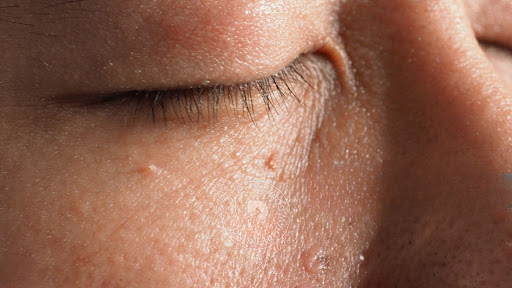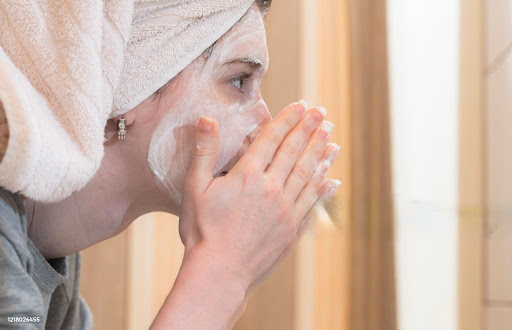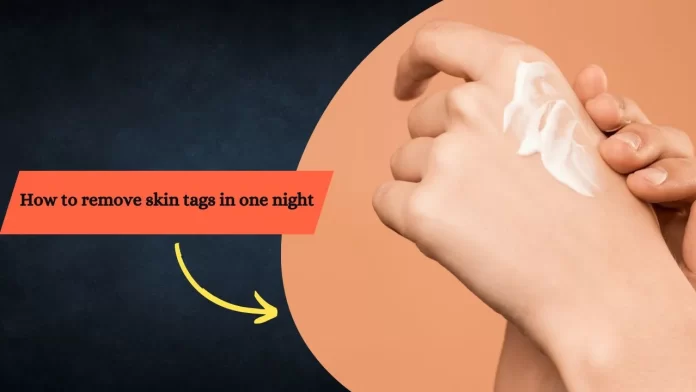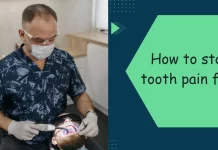Are you troubled by the ones pesky pores skin tags and searching for a quick answer? In this guide, we will reveal a powerful approach on how to remove skin tags in one night, supporting you awake with smoother, tag-unfastened skin. Say goodbye to those nuisances and hiya to self belief!
Table of Contents
What is Skin Tags?
Skin tags, also known as acrochordons, are small, benign growths that typically appear on the skin’s surface. They are often soft, flesh-coloured, and can vary in size, ranging from a few millimetres to a few centimetres in diameter. Skin tags are most commonly found in areas where skin rubs against skin or clothing, such as the neck, armpits, under the breasts, and in the groyne area. They can also develop on the eyelids, face, and other parts of the body.

Characteristics of Skin Tags:
- Appearance: Skin tags are usually small and can range in size from a few millimetres to about the size of a grape. They may appear smooth or slightly wrinkled.
- Location: Skin tags can develop on various parts of the body, including the neck, armpits, groyne, eyelids, and under the breasts. They often occur in areas where skin rubs against skin or clothing.
- Texture: Skin tags are soft and flexible to the touch. They may be slightly raised from the skin’s surface.
- Color: Skin tags are typically flesh-coloured or slightly darker than the surrounding skin.
Causes and Risk Factors:
Here are the causes and risk factors associated with skin tags:
Friction and Skin Rubbing:
Skin tags are more likely to develop in areas where skin rubs against skin or clothing. Friction and constant rubbing can irritate the skin, leading to the formation of these growths. Common locations include the neck, armpits, groyne, eyelids, and under the breasts.
Genetic Predisposition:
Family history and genetics can play a role in the development of skin tags. If your parents or close relatives have a history of skin tags, you might be more prone to developing them.
Hormonal Changes:
Hormonal fluctuations, such as those that occur during pregnancy or as a result of hormonal disorders like polycystic ovary syndrome (PCOS), can increase the likelihood of developing skin tags.
Obesity:
People who are overweight or obese are more susceptible to developing skin tags. The excess skin folds and increased friction in these areas create an environment conducive to their formation.
Ageing:
Skin tags tend to be more common as people age. They often appear in middle-aged and older individuals.
Diabetes:
There is a correlation between diabetes and the prevalence of skin tags. Insulin resistance and hormonal imbalances associated with diabetes may contribute to their development.
Pregnancy:
Pregnant individuals, due to hormonal changes and increased weight, are more prone to developing skin tags, particularly in skin folds.
How to remove skin tags in one night at home:
1. Tea Tree Oil:
Ingredients: Tea tree oil Cotton , ball or swab , Clean water
Steps:
- Clean the area around the skin tag with water and mild soap. Pat it dry gently.
- Dip a cotton ball or swab into tea tree oil, ensuring it’s well-saturated but not dripping.
- Apply the oil-soaked cotton ball directly onto the skin tag.
- Secure the cotton ball in place with a bandage or medical tape.
- Leave it on for a few hours or overnight.
- Remove the cotton ball and clean the area with water.
- Repeat the process daily until the skin tag dries up and falls off.

2. Apple Cider Vinegar:
Ingredients: Raw,unfiltered apple cider vinegar,Cotton ball or swab,Clean water
Steps:
- Clean the skin tag and the surrounding area with water and mild soap. Pat it dry.
- Soak a cotton ball or swab in apple cider vinegar, ensuring it’s fully saturated.
- Apply the vinegar-soaked cotton ball directly onto the skin tag.
- Secure it in place with a bandage or medical tape.
- Leave it on for several hours or overnight.
- Remove the cotton ball and wash the area with water.
- Repeat the process daily until the skin tag shrinks and falls off.
3. Garlic
Ingredients:
Fresh garlic clove, Clean water, Petroleum jelly (optional)
Steps:
- Clean the skin tag and the surrounding area with water and mild soap. Pat it dry.
- Crush or finely chop a garlic clove to create a paste.
- Apply the garlic paste directly onto the skin tag.
- If desired, you can apply a thin layer of petroleum jelly around the skin tag to protect the surrounding skin.
- Cover the area with a bandage or medical tape.
- Leave it on for a couple of hours or overnight.
- Rinse the area with water and gently pat it dry.
- Repeat the process daily until the skin tag diminishes and falls off.
Important Considerations:
- Patch Test: Before applying any remedy, do a patch test on a small area of skin to check for any adverse reactions.
- Consistency: Consistent application is key. Results may take several days to weeks to become noticeable.
- Discontinue If Irritation Occurs: If you experience irritation, redness, or discomfort, discontinue use and consult a healthcare professional.
- Consultation: If you’re uncertain about a skin growth or have underlying health conditions, seek advice from a dermatologist or healthcare provider before attempting home remedies.
Remember, while these home remedies are often suggested, they may not work for everyone, and there’s no guarantee of success. If you’re unsure or concerned, consult a healthcare professional for proper guidance and evaluation.
Professional Removal:

- For immediate and safe removal, consider consulting a dermatologist or healthcare professional.
- Dermatologists have the expertise to assess the best removal method based on the size, location, and number of skin tags.
- Scarring: Removal methods, especially cutting or cauterization, can cause scarring. Professional removal can minimise scarring.
- Post-Removal Care: Follow your dermatologist’s or healthcare provider’s instructions for post-removal care to ensure proper healing and reduce the risk of infection.
- Multiple Skin Tags: If you have multiple skin tags, it’s best to seek professional help rather than attempting to remove them all at once.
- Medical History: Inform your dermatologist of any medical conditions, allergies, or medications you’re taking before undergoing any removal procedure.
Medical Options:
Here are some common medical procedures used by dermatologists for immediate skin tag removal:
Excision:
- Procedure: Dermatologists use sterilised scissors or a scalpel to carefully cut off the skin tag at its base. Local anaesthesia may be applied to numb the area before the procedure.
- Benefits: Excision provides immediate removal and minimal scarring when performed by a skilled dermatologist.
- Considerations: Sutures or stitches may be required for larger skin tags. Proper aftercare is essential to prevent infection.
Cryotherapy (Cryosurgery):
- Procedure: Liquid nitrogen is applied to the skin tag using a specialised instrument. The extreme cold freezes the tissue, causing it to blister and fall off over the next few days to weeks.
- Benefits: Cryotherapy is non-invasive and generally well-tolerated. It’s suitable for multiple skin tags and requires no cutting.
- Considerations: Post-treatment blisters will scab and heal. Multiple sessions may be necessary for larger skin tags.
See also Buy best quality hand sanitizers
Cauterization:
- Procedure: A heated instrument or electrical current is used to burn off the skin tag. Local anaesthesia may be administered to numb the area.
- Benefits: Cauterization provides immediate removal and cauterised blood vessels, reducing bleeding.
- Considerations: Healing time varies, and there might be minor scarring or discomfort after the procedure.
Ligation:
- Procedure: A small thread or sterile suture is tied around the base of the skin tag to cut off its blood supply. This causes the skin tag to wither and fall off within a few days.
- Benefits: Ligation is a relatively simple procedure with minimal risk of infection or scarring.
- Considerations: Some discomfort and redness may occur during the process.
- Electrosurgery:
- Procedure: An electrical current is used to burn off the skin tag. Local anaesthesia is often used to numb the area.
- Benefits: Electrosurgery provides precise removal and can cauterise blood vessels to minimise bleeding.
- Considerations: There might be some discomfort, and healing time varies.
Important Considerations:
- Dermatologist expertise is crucial for safe and effective removal.
- Local anaesthesia might be administered to minimise pain during the procedure.
- Post-procedure care, such as wound cleaning and avoiding infection, is essential for proper healing.
- Some procedures may cause minor scarring, but the dermatologist will aim for the best cosmetic outcome.
- The specific procedure chosen will depend on factors like the size, location, and number of skin tags.
Overnight Removal Techniques:
Cauterization:
Method: Cauterization involves using heat to burn off the skin tag. This can be done using specialised tools, such as a cautery pen.
Considerations: This method should be performed by a healthcare professional. It may cause discomfort and minor scarring. Healing time varies.
Cryotherapy:
Method: Cryotherapy involves freezing the skin tag using liquid nitrogen. This freezes the tissue, causing it to eventually fall off.
Considerations: Often performed by a dermatologist, cryotherapy may cause temporary discomfort, redness, and blistering. Healing time can take a few days to a couple of weeks.
Ligation:
Method: Ligation involves tying off the base of the skin tag using a sterile thread or dental floss. This cuts off blood supply, causing the skin tag to eventually detach.
Considerations: This method requires precision and patience. It can be done at home but should be done carefully to avoid infection.
Excision:
Method: Excision involves surgically cutting off the skin tag using sterilised scissors or a scalpel.
Considerations: Best performed by a healthcare professional, excision may cause minimal bleeding and discomfort. Proper wound care is essential to prevent infection.
Over-the-Counter Solutions:
Method: There are over-the-counter products like skin tag removal creams and solutions that claim to dissolve skin tags over time.
Considerations: The effectiveness of these products can vary, and they may not be suitable for all skin tags or individuals. Consult a dermatologist before use.
Conclusion
The idea of how to remove skin tags in one night completely is not a realistic expectation, and attempting to do so might not yield the desired results. While there are various home remedies and medical procedures available for skin tag removal, most methods require consistent and patient application over a period of days to weeks. Quick removal within a single night is unlikely and could potentially lead to complications or adverse reactions.
When considering the removal of skin tags, it’s essential to prioritise safety, proper hygiene, and the expertise of a healthcare professional. If you’re looking for immediate and effective removal, consulting a dermatologist is recommended. They can assess the size, location, and characteristics of the skin tag to determine the most appropriate and safe removal method.
Whether you choose to explore home remedies or seek professional assistance, approaching skin tag removal with patience and caution is crucial. Prioritise your well-being by consulting a healthcare provider, especially if you have any doubts or concerns. Remember that while the desire for quick results is understandable, the health and safety of your skin should always be the primary focus.
Frequently Asked Questions
Q1: Can skin tags become cancerous?
Ans: Skin tags are benign growths and rarely turn cancerous. However, if you notice any changes, consult a dermatologist.
Q2: Will skin tags grow back after removal?
Ans: Skin tags typically don’t grow back after removal, but new ones may form in other areas prone to friction.
Q3: Is it safe to cut off a skin tag at home?
Ans: It’s not recommended to cut off a skin tag at home due to the risk of infection, bleeding, and scarring. Consult a professional.
Q4: Can skin tags be a sign of an underlying health issue?
Ans: In some cases, skin tags may indicate insulin resistance, diabetes, or hormonal imbalances. Consult a doctor for evaluation.
Q5: Are over-the-counter skin tag removal products safe to use?
Ans: Over-the-counter (OTC) skin tag removal products are available in various forms, including creams, gels, and solutions. These products typically work by causing the skin tag to dry up and eventually fall off.






















